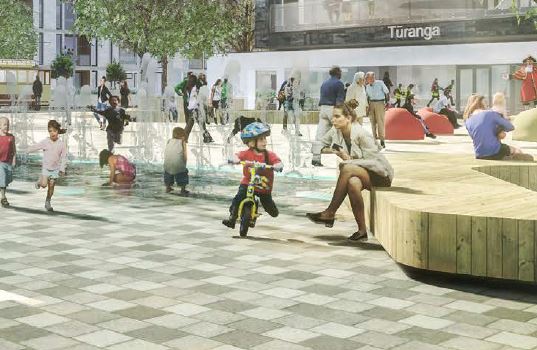You may have seen the new Cathedral Square concept plans released last week by Regenerate Christchurch. They have certainly generated lots of comment (positive and negative), and you might argue about the architectural merit of some of the development ideas. But there is no mistaking what the main intent of the exercise is:
“Anchored by rounded pavilions linked by a lattice-style overhead shelter, the new plan combines green and paved surfaces aimed at creating people-friendly spaces.”

So what exactly does “people-friendly” mean? We hear it a lot. A people-friendly place usually means that it is good for a wide range of people to move about, hang out, interact and engage. The proof in the pudding is when there are lots of people present in the space and they want to be there.
Usually the term people-friendly tends to focus on the pedestrian environment, i.e. what happens when you separate people from their vehicles. But does that mean that “people-friendly” should also be “cycle-friendly”?
-1024x572.jpg)
One word you won’t generally find mentioned at all in the Regenerate Chch material for Cathedral Square is “cycling” or “cycleway”. Actually I found one mention:
“There was strong support for making the area more pedestrian and cyclist-friendly, but clarity was needed regarding how transport and parking in and around the Square will work for hotel guests, service deliveries and taxis.”
This might lead some to think that cycling has been ignored (again…) and the centre of the city will be horrible for cycling. I tend to think the opposite will be true; the proposed revamp of Cathedral Square is likely to be very cycle-friendly too. This is because many of the same features that make a place good for pedestrians also make it good for cycling, including:
- Very little (or no) motor traffic allowed in an area
- Slow traffic speeds to improve the safety of unprotected users
- Wide open spaces to spread people out and reduce conflicts
- Lots of places to stop, chat and watch the world go by
-1024x450.jpg)
- Easy to get to/from different destinations (including linking with other travel modes)
- Active frontages for shops, cafes and other developments
- Engaging activities for people of all ages and backgrounds to enjoy (including families)
- An inviting place that is secure at different times of the day
There are lots of good resources out there on this topic, e.g. Project for Public Spaces. The key principle that enables these things to happen is that more of the street space is taken away from a pure motoring function (including parking). The upshot is that both walking and cycling get a greater piece of the pie, rather than often fighting over the same small slice.
In summary, making a people-friendly place generally results in a good cycling environment too. The reverse is also generally true; good cycling environments tend to be pretty good for walking but, for the sake of politics and inclusiveness, it may be a lot shrewder for advocates and decision-makers alike to call for a people-friendly city rather than a cycle-friendly one.

What do you think? Does “people-friendly” = “cycle-friendly”?

